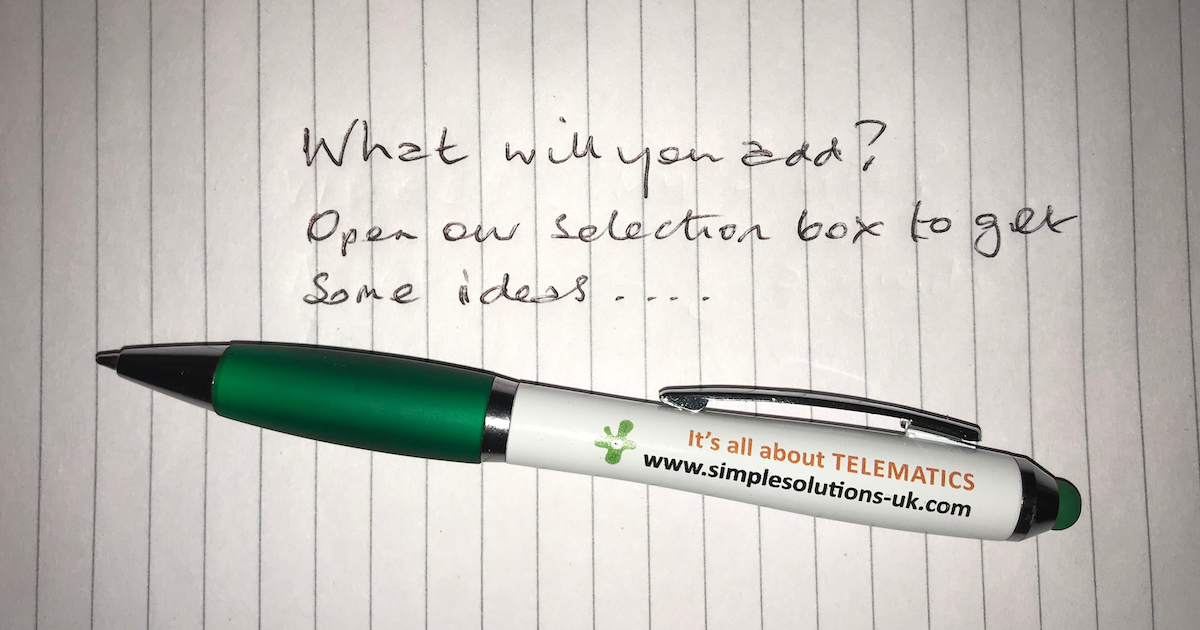News & Blog
Telematics: Accessory Selection

Adding features and function to your telematics solution.
Given the time of year, we thought we’d open our “selection box” of goodies and explain what can be added to many of the hardwired telematics devices out there (with i/o and serial connectivity).
There are endless combinations of features that can be added to make your solution unique, add value and revenue! Here are a few examples of solutions that can be quickly and cost effectively added to your solution.
Identification: we’ve covered before here Telematics: Identification
- Driver ID – isn’t it important for your clients to know who’s actually driving? Adding driver ID couldn’t be easier, is low cost but adds immediate value.
- Camera (snapshot) – why not add a snapshot camera for further identification of who’s in the drivers’ seat?
- Camera (video) – we’re all aware of the benefits of dash cams but did you know that some cameras will interface to telematics boxes to allow for video capture on a programmed event? Not that you would want to stream live video all of the time (imagine the data tariff you’d need!) but you might want to send a clip before and after an event.
Sensors:
- Temperature sensor – sensing temperature, obviously, but of what? Can be added to any (or multiple) parts of the vehicle (e.g. refrigerated compartments etc.) and set to be included in your data either routine or on exception.
- Fuel Sensor – a number of options here but the simplest install is the acoustic variant, giving you fuel levels that are accurate and usable to monitor usage and anomalies.
- Seatbelt sensor – simple hall effect solution that lets you know that the driver (and passenger) have belted up.
- Door Open Sensor – lots of ways to capture this but again, a low-cost solution that could be a life saver.
- TPMS (Tyre Pressure Monitoring Systems) – serial output from these retro-fit solutions allow accurate multi-tyre measurement information to be passed and recorded for safety and maintenance use.
Control:
- Relay control – immobilisation, remote immobilisation of a vehicle (when stopped) to inhibit ignition.
Driver Feedback:
- Buzzer (audible alarm) – the addition of this simple audible alarm, that can be triggered by a number of events and alert the driver to an action they need to perform.
- Driver Display (visible alarm) – either a single, multicolour or array of LEDs can be driven by the telematics device to show driving style or any alarm condition or driver feedback.
- Switch (custom use button) – this can be used for features like allowing the driver to select between personal and business miles.
- Garmin FMI – add navigation and bi-directional communication and route planning by interfacing to a suitable Garmin device and appropriate cable.
CAN: we’ve spoken about OBD devices here Telematics: OBD
However, there are many stand-alone CAN interface solutions with filtering and vehicle specific settings that can access diagnostic and ECU based data that can hook up to the telematics device and include CAN data in the payload. Capture of the data can be by parasitic ‘listener’ or direct connection to the vehicle via bespoke cables.
(We’ll be covering CAN in a later blog, so keep watching)
Others:
- Driver Behaviour – OK not so much a peripheral but certainly a low cost add on to your system, if not used already. Accelerometers within the telematics device allow measurement of harsh braking, cornering or acceleration and can help improve maintenance by re-education of drivers, amongst other, more obvious advantages in knowing how your, or your customers, vehicles are being driven.
- Satellite – for those parts of the World where there are no reliable cellular signals, there are devices with satellite only or dual cellular and satellite back-up.
- External antenna – most modern telematics boxes use very effective embedded antenna, a by-product of the handset market, however, sometimes the position of the box (and the vehicle it’s attached to) make it impossible, in these cases external antenna (either combined or individual cellular and GPS) are the answer and come in a large variety of packaging to suit almost all applications.
Just a selection of the solutions we can offer, to help you stand out from the crowd of ‘dots on a map’ add some peripherals and make the solution your own.To start a discussion and see what’s in our selection box get in touch and see how we can help you add value.